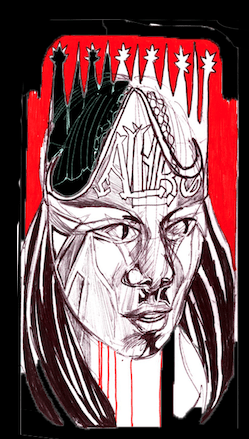In Thesis 2 I feel that I am making the same amount of progress as I have all year/semester. I just need to keep trucking because I’m at scary peak #2 (the first was the giant learning curve at the start) – circuit design, having functionality+aesthetics.
I feel that I need more assistance with: how to handle and develop different “features” like the curriculum, website etc when I am still working on making the product.
In the first five weeks of Thesis 2 I discovered/learned how to make Ruthenium and Sensidizer based dye cells, thus increasing my current capacity so that lighting an LED or charging a phone become more realistic. I have also begun the journey of trying to connect the cells and move into the aesthetic and artistic development of the project.
Comments on the studio? What is working or not working for you?
I do feel that this MVP presentation was spaced too closely to the last presentations. Also perhaps some 1:1 critiquing (for example, 30 minutes at the beginning + end of class where we could sign up for slot with Brad/Anezka and ask 5 minutes of questions or advice). Maybe inspiration slides of past successful theses, or professional development prep? Discussing more show logistics. The rest of the syllabus looks very on point as for what I need to prepare for. I am aiming to have major progress made by midterms so it is crunch time for me despite my current snags.
MVP responses:
Working) Title: Vibrant Cells & The Myth of Man
Medium / Form: Installation (Glass, Natural Dyes, Solder, Copper, Thermochromatic Ink, Paper, Paint)
Pitch: Vibrant Cells is a window installation of functional solar cells made by the artist. The piece is an example of how solar cells may be incorporated in architecture and artistic practices to store and provide energy. Weaving the language of energy, botany, chemistry, and circuit design through multimedia modules, the Vibrant Cells resource site showcases the range of aesthetics, costs, and efficiency differently designed solar cells can achieve.
Testing Methodology: In terms of the installation- Can the user read and understand the poem? Does the circuit work? How much are they understanding from the diagrams/learning material provided alongside? Are they even interested in how the project works? In terms of the curriculum, I have posted questions on the learning portfolio which investigate the user’s literacy in the topics related to the project.
———————–
Reflective five-paragraph essay: My thesis in context: where will it lead me?
My thesis has been leading me in so many directions it is overwhelming to think of getting everything I want to explore out of the way before I graduate. This project could be life long, but I keep reminding myself to hold my horses and carve out what is the most vital element of the project to be presented in May, that I can build off later.
Over and over again this has proven to be a functional prototype with a visible load (like a light or a phone charger), which sounds simple but in actuality has taken a significant amount of trial and error. Costly materials have temporarily moved me away from my original idea of a low cost, DIY assembly solar cell, since to make it efficient I have had to upgrade to better materials; however I do think I can continue exploring and refining methods to make the cells more accessible to people without funding. Throughout the research process I have collected documents to help assist this future endeavor.
Going back to the poem I plan to attach to the piece as a load I really love it as a piece and as a message but I’m not sure its 100% cohesive with the tone of the cells. The cells have so much to say on their own I’m now backtracking on the poem idea, since it would be a lot of work and if it doesn’t strongly support the project perhaps I should invest my time in creating more prototypes to showcase the variation in style possible.
The curriculum has been developing but I haven’t put much time into making it more non-scientist friendly. As of now it reads as a straightforward but maybe boring manual, so it needs graphics and better communication design. I’ve started the process of setting up a website but I’m using an old domain since I haven’t settled on a title yet. I really would like to use the website as an opportunity to learn web development but that makes it a much longer term project.
Most importantly I must continue roughing it with the scientific aspect of the cells: finding ways to make them connect properly and look legitimate, as well as continuing to explore ways to boost efficiency.
My second priority is the curriculum/information design: how will the cells be explained when I am not around?
The cells will be presented in two upcoming STEM education conferences in March & April.
If I can accomplish these three things (efficiency, communication, presentation) I will be satisfied. If there is time to develop more, I will showcase more DIY, homemade material prototypes to reinstate to the original incentive of the project. I would love to make a short video describing the process and concept (perhaps this should be bumped up the priority list to live with curriculum/ information design). After this will be the development of the site, later on the addition of a forum for citizen scientists, disseminating the curriculum, more workshop hosting, and possibly establishing a business for solar windows/art.



